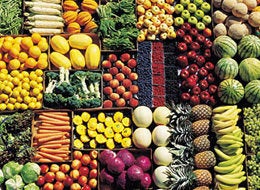
Over the past several days, my family and I have been driving across country. A couple days ago, we were in Moab, a remote part of Utah situated in the heart of red-rock country. One evening, my daughter and I took a boat ride up the Colorado, the trip narrated by a crusty old-timer with a great love of the land and an almost equally great suspicion of outsiders. Moab was, he told his passengers proudly, over a hundred miles from the nearest Wal-Mart. It was, quite simply, splendidly isolated.
Now, in Moab's case, distance from big-box stores is, indeed, something to be happy about. The town is self-contained, afloat on tourism dollars, replete with decent local stores and affordable eateries. To my mind it's a wonderful thing that places like Moab still exist largely outside of the geography of big-box America.
But for millions of Americans these days, "desert" means something radically different from, and less romantic than, the splendor of Moab. As the economic vise grips more and more people, increasingly the options for meeting basic survival needs (the purchase of food, access to medicines, and so on) are being squeezed. In rural regions across the country, food workers now openly talk of "food deserts," places where locals have no access to large, affordable food outlets without driving scores of miles. And, with money tight and gas prices on the rise again, that's not a viable option for many of these individuals. For them, the lack of big stores in their towns and villages is a curse rather than a blessing. It represents a consignment to hunger and a humbling reliance on charity (or on over-priced gas station stores selling little more than fast-food and junk food).
Visit any small-town food pantry these days and you'll see men and women, young and old, who for the first time in their lives are scared not just that they'll run short of money but that they'll open their fridge one morning and realize there's literally nothing left to eat.
In my previous Huffington postings on Breadline USA I have detailed anti-poverty policy responses to tackle the growing below-the-radar hunger crisis in America. Today, though, I want to talk about food.
There's something clearly wrong with a system of production and distribution that leaves many rural residents with no local source of food. After decades of policy approaches that favor large, corporate food distributors over small-scale operatives we see a crazy end-product: people closest to areas where food is grown often have no ready, nearby, access to buying affordable, healthy food. If we're going to rely almost exclusively on supermarkets to get food from farmer to consumer, we need to find ways of subsidizing their placement in out-of-the-way communities otherwise bypassed by the market.
More importantly, in the long-term we need to re-cultivate local food markets, from fruit-and-vegetable stalls on up to local butchers, as well as the growing of family kitchen gardens. Until the very recent past, such a business model and food cultivation system was the norm. In letting it lapse, in assuming millions of people would forever have the resources to drive an hour or more to the supermarket to pick up food supplies, we dangerously undermined our own community security
But those are long-term goals; in the short term, we need to work on getting healthier foods into the hands, and stomachs, of the growing numbers of poor families eking out their lives on the breadline margins of America. Too often, food banks and food pantries have to work with society's crumbs: old, starchy, fatty, sugary, foods. That is, of course, better than nothing. But it's obviously not as good as channeling fresh fruits and vegetables to the pantries to distribute.
That's where groups like Ample Harvest come into the picture. Begun last year by West Milford Community Garden director Gary Oppenheimer and a couple other colleagues, the group uses the Internet to link up kitchen garden growers with surplus produce on their hands with local pantries.
Ultimately, Ample Harvest's goal is to create databases which will quickly, and easily, show what sorts of foods are needed by which pantries. The group's members could then drop off fresh bags of produce, and, in Oppenheimer's words, the hungry would have a chance at eating food "fresher" than that bought in the supermarket.
It's an idea that grew out of Oppenheimer's own experiences. One year, a few years back, he harvested about forty pounds more fruit and vegetables than he could use. He couldn't bear to see it going to waste, and he wasn't interested in selling it, so he took the food over to a local shelter for battered women. The response was overwhelming. Now, the director of the shelter told him, her clients could finally have a decent meal. The next year, he took another few bags of food to the same shelter come harvest time; again, the response was an eye-opener for Oppenheimer. For the first time in months the women would once more get fresh fruit and vegetables.
It's a win-win model: the kitchen growers have the satisfaction of seeing their surplus food being eaten, and enjoyed. Impoverished pantry and shelter residents get to eat decent meals. And, down the road, the health care system saves money because the population is eating better, healthier, fare.
Of course, by themselves, groups like Ample Harvest can't raise people out of poverty and hunger. But they're a good start, a good example of how during tough times individuals can pull together to help their neighbors and shore up their communities.